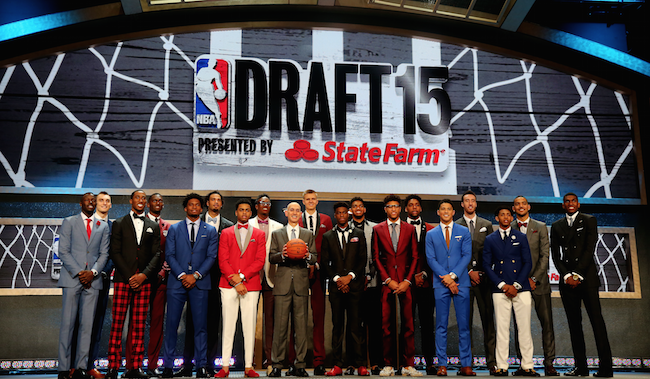
First thing’s first: The 2015 NBA Draft isn’t about Thursday night, or even this time next year. We won’t know how this class will ultimately pan out until well into the next decade; anyone saying differently is lying, either by personal convenience or a complete lack of understanding when it comes to the evolution of basketball players. As long as that crucial context is taken into account, though, there’s still room for immediate analysis when it comes to draft proceedings.
These grades aren’t a reflection of a prospect’s talent or his fit on a new team alone, but instead some amalgam of those characteristics, one that differs depending on when individual selections were made. Some franchises deserve praise for their choices, some warrant scrutiny, and others merit something in between.
Just remember, however, that these grades aren’t going on a general manager’s permanent record. A failing one today could be a passing one in three years’ time and vice versa. They’re fluid, just like the fortunes of the youngsters and teams on which they’re based.
Atlanta Hawks: D
Picks/Trades: Traded the 15th pick to Washington for the 19th pick and a pair of future second-rounders, then dealt the 19th choice to the New York Knicks for Tim Hardaway, Jr.; Marcus Eriksson (50)
The Hawks’ decision to trade from No. 15 to No. 19 was one thing. It made sense for the team to pick up future assets while moving back only a few spots in a deep draft. What didn’t was the decision to then trade that mid first-round choice for a player who many thought could be had for a late second-rounder.
There’s something to be said for the toxic atmosphere in which Hardaway existed the first two years of his career. Fortunately for the the 23-year-old, though, the Hawks aren’t the Knicks, and it’s easy to imagine him playing better in Atlanta than he ever did in New York, should he get the playing time to do so, of course. Regardless, a first-round pick was needlessly steep price to pay for a player of Hardaway’s caliber.
Boston Celtics: B
Picks: Terry Rozier (16); R.J. Hunter (28); Jordan Mickey (33); Marcus Thornton (45)
So much for that highly-anticipated draft night trade. Danny Ainge only has much influence over a potential trade suitor, though, and did fairly well to rebound from the disappointment of staying put by adding proven talent to his roster.
Rozier, though, still seems a reach in the mid first-round. The Louisville guard is cut from the same cloth as Avery Bradley and Marcus Smart, a plus athlete whose most natural skill is the ability to play disruptor on the perimeter. But his Rozier’s jumper is barely good enough to be considered streaky, and he lacks the feel and nuance befitting a quality backup point guard. That Boston is overloaded with ballhandlers in the backcourt only makes this pick more vexing.
Hunter is the prize here. At times considered a potential late lottery pick, the lanky 6-foot-6 wing is arguably the best shooter in this draft – despite underwhelming numbers in his final season at Georgia State. And though he won’t be known as a playmaker, Hunter has the natural passing ability to thrive in Brad Stevens’ motion-heavy, side-to-side attack.
Mickey, too, represents great value. He’s limited offensively, but has the physical tools and defensive disposition necessary to carve out a niche as a quality reserve big man.
Brooklyn Nets: B+
Picks/Trades: Chris McCullough (29); Traded the 41st pick, Pat Connaughton, and Mason Plumlee to the Portland Trail Blazers for Steve Blake and Rondae Hollis-Jefferson, the 23rd choice; Traded a pair of future second-round picks to the Charlotte Hornets for Juan Vaulet, No. 39
Remember when Plumlee was a bright spot for the Nets midway through last season? Billy King barely does, either. Still, Brooklyn received fair value for the 25-year-old leaper and may have found a steal with its original draft pick, too.
Hollis-Jefferson is one of our favorite players in this class. The 6-foot-7, 215-pounder could be the best rookie defender in the league next season due to his combination of quick feet, long arms, and relentless playing style. The questions for Hollis-Jefferson have always come on the other end, where he’s a wholly unreliable shooter from the perimeter – a near death-knell for wings in the modern NBA. But the former Arizona star can be an effective straight-line penetrator due to his size and speed, and has shown an ability to exploit weakness in the defense by finding creases for off-ball cuts. If Hollis-Jefferson’s ever comes around, he’ll be a very, very good player. As it stands, though, he projects as a near-elite perimeter defender, potential that makes him a great value with the 23rd pick in the draft.
The Nets did very well to bring in McCullough near the end of the first round, too. The Syracuse freshman was a potential lottery pick before tearing his ACL in January, a run-and-jump power forward with a 7-foot-3.5 wingspan who was one of the most pleasant surprises of the early college basketball season. But McCullough came back to earth after that awesome start, failing to eclipse more than seven points in each of his previous eight games before suffering a season-ending injury. The 20-year-old certainly won’t help Brooklyn next season and likely the one after that, too, but could emerge as a valuable contributor several years down the line.
Losing Plumlee won’t hurt the Nets, and is the most convincing sign yet that the team will do whatever it can to sign Brook Lopez in July. While it’s pretty to think that a seven-footer with high-level athleticism could fetch more than a late first-round pick and a journeyman point guard, the market for a limited player like Plumlee proved far more realistic.
Charlotte Hornets: D+
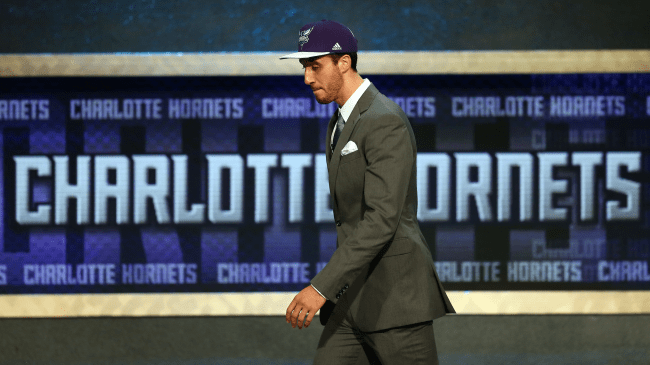
Picks/Trades: Frank Kaminsky (9); Acquired two future second-rounders from the Brooklyn Nets in exchange for Juan Vault, No. 39.
There Justise Winslow sat, one of the draft’s several best prospects still on the board as the late lottery approached. It would have been easy for Michael Jordan and company to take best player available regardless of a presently awkward fit. Always true to themselves, though, the Hornets stayed confusing and passed up a golden opportunity to make Kaminsky the latest addition to their reconstructed frontcourt.
This grade is more about Charlotte than it is about Kaminsky. The sweet-shooting Wisconsin big man is one of the most skilled offensive players in the draft, and could emerge as an extremely valuable third big man. He’s an easy plug-and-play for Steve Clifford’s space-averse team, too.
But the Hornets simply overthought this one. The offensive weaknesses of Winslow and Michael Kidd-Gilchrist could have indeed made them a crippling pair on the wing long-term. The Duke freshman isn’t the shooter his sterling college numbers suggest, and might lack the wiggle to be a reliable secondary ballhandler. Still, the prospect of he and MKG wreaking havoc defensively and running wild in transition should have been too tempting for Jordan to pass up.
Alas, he stayed even safer, filling a more obvious need with a player whose ceiling fall well below that of the guy the Hornets could have had. Here’s hoping Kaminsky thrives in Charlotte. Regardless, it’s easy to think drafting him will come back to Charlotte in several years’ time.
Chicago Bulls: C+
Picks: Bobby Portis (22)
Talent or need? That’s an easy choice at the top of the draft, but one far more difficult to make the farther you get from the lottery.
Portis will be a valuable NBA contributor for a decade. He’s too skilled, strong, and relentless for any other outcome. But was he really the best choice for Chicago here? A team so stacked with big men that it played Nikola Mirotic on the wing in 2014-15? No way, especially when a sniper like R.J. Hunter was still on the board as the Bulls’ clock began ticking at 22nd overall.
It’s just hard to believe that Portis will be able to find minutes for Fred Hoiberg next season. Could Chicago have made this pick knowing that both Joakim Noah and Pau Gasol will be free agents following 2015-16? Likely. But for a team firmly in win-now mode despite a ballyhooed shuffle on the sidelines, selecting a player who could immediately help fill an obvious hole makes more sense to us.
Cleveland Cavaliers: B+
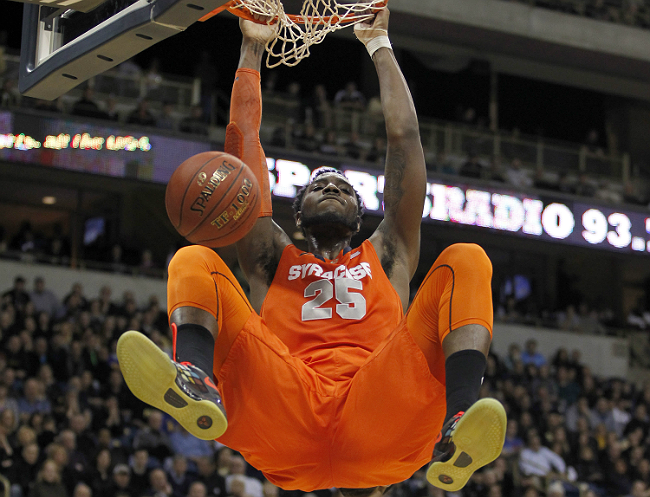
Picks/Trades: Traded the No. 24 pick, Tyus Jones, to the Minnesota Timberwolves for Nos. 31 and 26, then drafted Cedi Osman and Rakeem Christmas
Cleveland is primed to pay the luxury tax next season, and thus had no intention of adding a guaranteed salary to the books on Thursday night. By trading Jones for a pair of second-rounders, David Griffin’s mission was accomplished.
We won’t pretend to know much about Osman, other than that the 20-year-old Turk looks like a fraternity brother you either want to punch, get drunk with, or both.
Christmas, though, is a favorite around these parts. The Syracuse big man enjoyed a career campaign in his senior season, living up to the lofty rankings that accompanied him as a prep. At 6-foot-10, 245 pounds with an incredible 7-foot-5 wingspan and soft touch in the paint, he’s likely find a role in the NBA as a backup big man. Whether or not it will come with the frontcourt-heavy Cavaliers, however, remains to be seen.
Dallas Mavericks: A-
Picks: Justin Anderson (21); Satnam Singh (52)
Monta Ellis, Chandler Parsons, Richard Jefferson, and Devin Harris played more minutes off the ball than any other players for the Mavericks last season. While that group didn’t necessarily present a major talent deficiency on a nightly basis, it still hamstrung Rick Carlisle for an absence of versatility. Dallas’ athletic wings were small, it’s big wings were lumbering, and none of them were plus defenders.
That’s what makes Anderson such a perfect fit here. The 6-foot-7, powerfully built Virginia product will be a prototype “3-and-D” performer if his junior season shooting numbers prove sustainable. He shot 45.2 percent from three-point range in 2014-15, over 15 points better than his career average. Which Anderson will the Mavericks be getting? He didn’t perform well in shooting drills at Draft Combine, but rest assured that Mark Cuban wouldn’t have selected the lefty if he thought Anderson couldn’t knock down open shots. It bears mentioning that Carlisle is hands-on teacher, too, who went out of his way work with Ellis on his shot upon the latter’s signing two years ago.
Dallas made history on Thursday night by taking Singh late in the second-round. The 7-foot-2 behemoth became the first Indian-born player to ever be drafted, and for that he deserves a hearty congratulations. While we hope he beats the odds to make a roster at some point in his career, though, his supreme lack of experience and foot-speed make those chances slim.
Denver Nuggets: B+
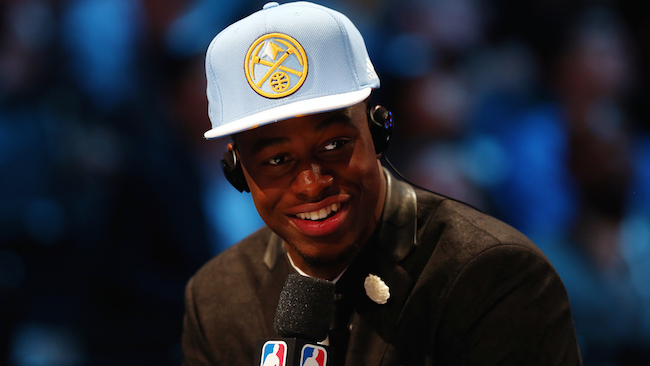
Picks: Emmanuel Mudiay (7); Nikola Radicevic (57)
Mudiay was commonly mocked to the New York Knicks at No. 3, and few thought he’d get past the Sacramento Kings at No. 6, either. What a boon for Mike Malone rebuilding team, then, that the big, talented lead guard experienced an unexpected mini slip on draft night.
Even if Ty Lawson’s status with the Nuggets wasn’t so tenuous, the team would merit a high grade for taking Mudiay. He was arguably the best player available on the board, and seems a perfect fit the for up-and-down style Malone has preached since taking the reins earlier this month. And though the 6-foot-5, 200-pounder doesn’t boast the incredible vision and playmaking knack of D’Angelo Russell, he clearly has the feel of a lead ballhandler. Mudiay’s jumper is shaky and he’s not quite the athlete high school mixtapes suggest, but he has the chance to star on both sides of the ball nonetheless. How many point guard prospects possess that possibility?
And that Lawson and Denver have grown so disenchanted with one another, of course, only makes this choice more of a no-brainer. We’re not as convinced that Mudiay will scrape his potential as we are several other elite prospects in the 2015 class. The mere prospect he will, though, makes him a worthy choice at No. 7.
Full disclosure: We know nothing about Radicevic save for the fact he played with Kristaps Porzingis.
Detroit Pistons: B+
Picks: Stanley Johnson (8); Darrun Hilliard II (39)
We went back and forth on this one.
It was shocking to see the Pistons pass on Justise Winslow here. He’s almost universally considered a superior prospect to Johnson, and both players are likely to play similar roles on the next level. But digging below the surface offers crucial context that makes the Arizona manchild a more intriguing player than many believe.
At just 19 years old, Johnson measured at 6-foot-6.5, 242 pounds with a 6-foot-11.5 wingspan, affording him the potential ability to play small-ball power forward in a downsized game that Winslow lacks. Size matters on the perimeter more than ever in traditional lineups, too, as wings are increasingly tasked with helping on rolling big men at the rim. That Johnson stands a better chance to fare well in those frequent scenarios than Winslow matters, even if his skills as a ballhandler don’t quite match up by comparison.
The choice between both star freshman, frankly, just wasn’t nearly as simple as we originally believed. But Stan Van Gundy obviously got his man here, and we’re willing to give Detroit’s czar benefit of the doubt after conducting further research.
The Pistons are no doubt hoping that Hilliard, a senior from Villanova, will provide the immediate spacing it will take Johnson some time to develop. The 6-foot-5 wing shot 38.7 percent and 41.4 percent in each of the past two seasons, respectively, on over five tries from beyond the arc. Does he have the quickness to stay with opposing guards, though? We’ll see.
Golden State Warriors: A
Picks: Kevon Looney (30)
One of our favorite moments of the draft was watching Adam Silver announce Looney’s name with the final pick of the first round. The UCLA forward was invited to the Green Room by the league on Thursday, but experienced a major slide due to reports of injuries to his hip and back. Looney and his family exited left the area as picks proceeded in the high 20s, assuming his chances of being drafted before the end of the first round were over.
But Golden State ended his slide, and the joy in Silver’s voice and on his face was obvious as the commissioner made the pick and watched Looney walk to the stage. Needless to say, it was a great moment.
Bob Myers should be feeling similarly good about it, too. The super-long 19-year-old power forward was once considered a lock for the top-10 based on his combination of size and potential skill-set, but that thinking proved premature. Whether Looney has surgery on his troublesome hip or not, he was unlikely to play for champs in his rookie season. If he can achieve and sustain a clean bill of health, though, the Warriors will prove even richer. What team couldn’t use a player with his package of physical gifts and burgeoning offensive skills?
Houston Rockets: C
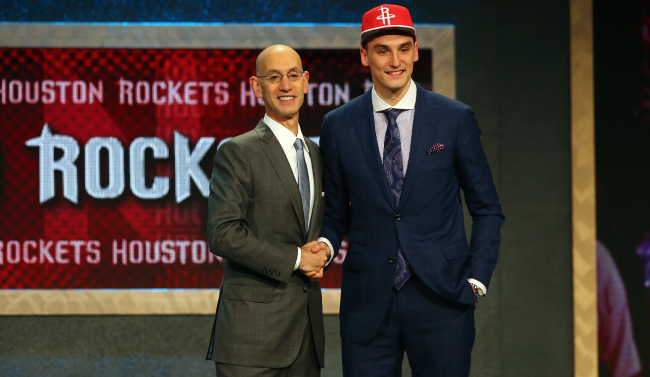
Picks: Sam Dekker (18); Montrezl Harrell (32)
Call this a tale of two picks for the Rockets.
We’re not as high on Dekker as most. The Wisconsin hero’s starring turn in the NCAA Tournament simply wasn’t an accurate reflection of his career in Madison. He averaged 19.1 points per game on 40.1 percent from while leading the Badgers to the championship game, numbers that stick out like a sore thumb compared to season-long ones he compiled as a junior, sophomore, and freshman. Bottom line: We’re dubious Dekker is the shooter basketball fans across the country grew to believe he is. And if that’s the case, just what else does he do at an exceptionally high level?
It’s also hard to envision Dekker breaking into Kevin McHale’s rotation any time soon. Trevor Ariza and Kostas Papanikolaou are ahead of him at small forward, and the team’s glut of power forwards means he’s unlikely to receive minutes as a small-ball 4. And with Patrick Beverley facing restricted free agency, it would have been nice to see point guard addressed, perhaps with a guy like Delon Wright.
Harrell, on the other hand, represents fantastic value as an early second-rounder. Projected as a solid first-round pick throughout his collegiate career, the Louisville product is a fantastic athlete and gifted rebounder who recently began to flash some comfort as a jump-shooter. The only thing hold him back? Size, but even that’s an exaggerated concern. Harrell compensates for his 6-foot-6 height with a bonkers 7-foot-4 wingspan.
How does he fit in Houston? It’s hard to tell. But taking the best player available is almost never a bad choice, and that remains the case here.
Indiana Pacers: B-
Picks: Myles Turner (11); Joseph Young (43)
Credit Larry Bird for thinking big picture. With Paul George poised to regain his All-Star form in 2015-16, it would have been easy for Indiana to take a player who could provide an immediate impact with the 11th overall pick, especially considering potential defections of long-time frontcourt stalwarts. But Bird took the player with the highest ceiling, and he deserves credit for doing so.
The issue is that we’re just not very high on Turner. He sounds awesome on the surface: A 6-foot-11 teenager with elite length, natural shot-blocking instincts, and a stroke that suggests future three-point range. But the Texas freshman just doesn’t move as well as you’d assume, and his rebounding instincts leave much to be desired. And if Turner isn’t quick enough to handle pick-and-rolls or tough enough to bang on the interior, just how will he get by defensively? We hope we’re wrong on Turner, though. His fully realized game would be a perfect fit for the modern NBA.
A similar line of thinking applies to Young. Some league followers projected him as a late first-rounder, so the Pacers should feel good about snatching him in the middle of the second round. He’s a shoot first, second, and third type of player, however, the kind that clashes with our entire basketball ethos.
Again, our “problems” with the Pacers’ draft are more personal than anything else. Many are deeming Thursday an impressive haul for Frank Vogel’s team, and we wouldn’t be shocked if both Turner and Young emerge as valuable contributors at some point in their careers.
Los Angeles Clippers: C
Trade: Acquired the No. 56 pick, Branden Dawson, from New Orleans in exchange for cash.
The Clippers got to play on draft night after all! We like Dawson. If he could develop any semblance of a shooting stroke, the 6-foot-7, 230-pounder could function as an ideal small-ball power forward in a pinch. But the Michigan State product made just 49 percent from the free throw line during his senior season, casting extreme doubt on that possibility.
Los Angeles Lakers: A-

Picks: D’Angelo Russell (2); Larry Nance, Jr. (27); Anthony Brown (34)
All hail Mitch Kupchak! The Lakers could have crumbled under the weight of public perception and taken Jahlil Okafor, the player who a majority considers the second-best player in the draft. But they stayed true to themselves, and are poised to reap the benefits of that approach for years to come.
Confession: Russell is our favorite player in this class. The 6-foot-5 Ohio State lead guard is the kind of offensive savant from which league-leading systems are built. He’s a willing and creative passer; effortless and nuanced dribbler; and has the shot-making ability that forces defenders to play him honest. After watching Russell jump 39 inches in pre-draft workout video, we were absolutely sold on his future as a potential All-Star. He won’t fail; the degree of his success is what’s up in the air, which is far more than you can say for any draft prospect save for Karl-Anthony Towns.
In seven years, Russell could be a foundational cornerstone for Los Angeles. A bonus: He can even play alongside rookie surprise Jordan Clarkson in the backcourt. From every perspective, this was a fantastic pick.
We’re not nearly as enamored with the Lakers’ choice of Nance. Why take a more established player like Montrezl Harrell to beef up the frontcourt? Or a more promising one like Kevon Looney? Kupchack had some talented guys fall to him at No. 27, and chose one who’s entirely unspectacular.
Don’t be surprised if Brown makes the team. He’s an absolute dead-eye shooter with good size.
Memphis Grizzlies: C
Picks/Trades: Jarell Martin (25); Traded Jon Leuer to the Phoenix Suns for the No. 44 pick, Andrew Harrison
Martin by himself doesn’t look good for Memphis on the surface. Though he played on the wing for stretches at LSU, the 6-foot-9, 240-pounder lacks the lateral quickness to stick with the world’s best perimeter players. He’ll play down low for the Grizzlies, then, where the team has a surplus of talent led by Marc Gasol and Zach Randolph.
But here’s the thing: It’s possible that Kosta Koufos walks in free agency; the team already shipped out Leuer; and Jeff Green never got comfortable the mobile 4 Memphis has long sought. Could Martin play that role? With his combination of size and natural scoring ability, that certainly seems his destiny – albeit in a reserve role. However, Martin won’t realize it next season, which makes his selection by the win-now Grizzlies confusing.
Couldn’t Memphis have used this pick to pick up the slack of Vince Carter? R.J. Hunter was still on the board, after all. And while shedding Leuer makes sense, Harrison has long-shot odds at making the roster, too.
Miami Heat: A+
Picks: Justise Winslow (10); Josh Richardson (40)
The big winner of draft night, Miami did what the Pistons and Hornets failed to before them: take Winslow, arguably the fourth-best player in this class.
There’s no guarantee the Duke freshman will be a star, let alone an impact player. Winslow measured on the short side at the pre-draft combine, isn’t the long-range shooter his college numbers suggest, and lacks the explosive athleticism so many seem to assume he possesses. But who cares? The 19-year-old will be a plus defender and transition terror throughout his career, and even boasts the playmaking knack to emerge as a capable secondary ballhandler, too. If the jumper ever comes around, Winslow could emerge as one of the best all-around wings in the league – and the Heat got him with the 10th pick.
Irrespective of Dwyane Wade’s impending free agency, this is a major, major coup for Miami. We can’t wait to watch Winslow play next season, especially if the Heat can bring back the band and make a run to home-court advantage in the East.
Richardson, a late bloomed out of Tennessee, is a high-level athlete with ideal length at guard. Though he’s extremely adept at any aspect of the game offensively, his potential on the other end makes him a perfect second-round flier Miami.
Milwaukee Bucks: C+
Picks/Trades: Rashad Vaughn (17); Traded a 2017 first-rounder and the No. 46 pick, Norman Powell, to Toronto in exchange for Greivis Vasquez
Giving up a first-round pick for Vasquez is a relatively steep price to pay. Though he’s become on the best reserve point guards in the league in the past two seasons, it’s not like he significantly moves the needle for Milwaukee. That Vasquez’s contract expires after next season is a problem, too. Might this deal say most about the Bucks’ feelings on Michael Carter-Williams? There were rumors leading up to the draft that he was being floated in potential trades. A silver lining is that the surrendered draft pick is lottery-protected; John Hammond likely won’t miss a potential star at the expense of acquiring Vasquez.
Vaughn yields a more optimistic assessment. He was a high profile recruit who put up major numbers in his lone season at UNLC. But will he able to grasp advanced basketball strategy and learn to play within the team concept? If age proves Vaughn’s only issue, Milwaukee will have found a steal in the middle of the first round. You just can’t teach Vaughn’s scoring instincts.
Minnesota Timberwolves: A
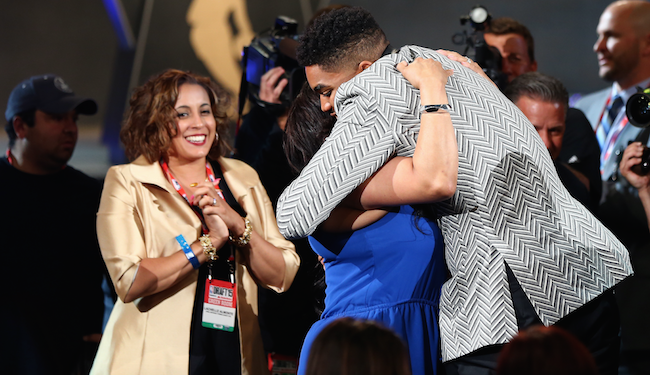
Picks/Trades: Karl-Anthony Towns (1); Traded the No. 31 and No. 36 picks to Cleveland for the No. 24 pick, Tyus Jones
Towns has been the top player on our big board since early this year. He was an absolute no-brainer pick for the ‘Wolves.
There’s only so much left to be said about a prospect of his outstanding caliber, but we’ve come up with something: Towns is a center, people. Stop trying to make an athletic seven-footer with elite shot-blocking instincts and shooting range to 20-feet a power forward. Doing so would not only mitigate the strengths that make him such an intriguing player, but needlessly complicate matters for Minnesota from a schematic standpoint, too. Towns is a 5, and he’s going to be a damn good one.
Jones is a similarly seamless fit for the Timberwolves, and not just because he’s a Minneapolis native. Anyone tasked with the misfortune of watching Minnesota consistently last season surely noticed the team’s utter lack of ballhandlers in Ricky Rubio’s extended absence. While Jones isn’t a sexy player and has obvious deficiencies, he’s a natural point guard who should make life easier on Andrew Wiggins and Towns when Rubio is off the floor. And that’s what this time is really about for the ‘Wolves, right?
New Orleans Pelicans: N/A
Trade: Dealt the No. 56 pick, Branden Dawson, to the Clippers for cash.
New York Knicks: A
Picks/Trades: Kristaps Porzingis (4); Traded Tim Hardaway, Jr. to Atlanta for the No. 19 pick, Jerian Grant; Acquired the No. 35 pick, Guillermo Hernangomez, from Philadelphia for a pair of future second-rounders
The Big Three were off the board, so what was Phil Jackson to do? Go safe and select Justise Winslow? Force Emmanuel Mudiay into the Triangle? It took gumption for the Knicks to select Porzingis here, and we’re expecting it to pay off with a player who has the chance to be a star.
So much of the criticism surrounding the sweet-shooting Latvian big man is related to past experiences with European players. New York fans hear his name and immediately think of Andrea Bargnani and Frederic Weis, while draftniks everywhere no doubt recall Jan Vesely and Nikoloz Tskitishvili. Obviously, that’s not fair. If afforded the chance to stand on his own merit as a prospect, a majority would see Porzingis for not just the extremely unique talent he possesses, but also his solid performance for Baloncesto Sevilla in the ACB League.
Did you know that he averaged 12 points, four rebounds, and 1 block in 21 minutes per game during the Eurocup? On 55 percent shooting overall and 46 percent from beyond the arc? Combined with his 7-foot-2 height, rare coordination, and effortless shooting stroke, those numbers should be more than enough to make Porzingis an understandable selection at fourth overall – whether he ultimately lives up to that lofty draft position or otherwise.
Adding Porzingis was a good move. Swapping Hardaway for a mid first-round pick, though, was Jackson’s best one on Thursday night. Grant has an obviously shallow ceiling due to his age and somewhat shaky jumper, but 6’4 defenders who can run pick-and-rolls effectively are few and far between. The former Notre Dame star will be in the league a long, long time.
Oklahoma City Thunder: B
Picks: Cameron Payne (14); Dakari Johnson (48)
What can you reasonably expect from a team boasting Kevin Durant, Russell Westbrook, and Serge Ibaka with picks in the middle of each round? Players with the chance to be solid contributors who could help put Oklahoma City over the hump, and that’s exactly what Sam Presti provided.
It’s no secret the Thunder target Payne in the pre-draft process. Playing under the radar at little Murray State, he established himself as one of the best floor generals in this class with a stellar sophomore season that saw him average 20.2 points and 6.0 assists per on solid all-court efficiency. It’s just hard to imagine a player with Payne’s physical profile and mental makeup to fail, even if it’s similarly difficult to imagine him developing into a star. But Oklahoma City could use another capable ballhandler whether Durant and Westbrook re-sign for the long-haul or otherwise, and found one here at the very least.
A seven-footer with a wide body and soft touch, Johnson was overshadowed by superior frontcourt prospects in his time at Kentucky. With Ibaka, Steven Adams, Mitch McGary, and Nick Collison all signed through 2016-17, his court-time will be fleeting. Regardless, this was another good value pick by the Thunder.
Orlando Magic: A-
Picks: Mario Hezonja (5); Tyler Harvey (51)
Ah! The perfect amalgam of filling a need and taking the best player available.
We’re still not sold on Hezonja. His size, athleticism, and skill-set are all wildly intriguing. There’s a reason, after all, he was a consensus top-seven prospect in a such a talented class. But players with his outwardly arrogant on- and off- court persona normally boom or bust; they’re just not cut out for anything in between. Having said that, Hezonja will be an absolute star for the shooting-challenged Magic if he can live up to his potential. Known most for his limitless shooting range, the 20-year-old is a developing playmaker and has the foot-speed to thrive defensively, too.
A note of caution: Scott Skiles is a notoriously gruff and strict head coach. Will Hezonja hold his head high if his career gets off to a rocky start? Basketball fit matters, but chemistry fit does, too, and this one seems dangerous.
Harvey took a whopping 9.3 trey per game in his junior season, connecting on a remarkable 43.1 percent clip. He’s one-dimensional, but Orlando needs all the floor space it can get, and the Eastern Washington junior has the chance to provide some.
Philadelphia 76ers: B+
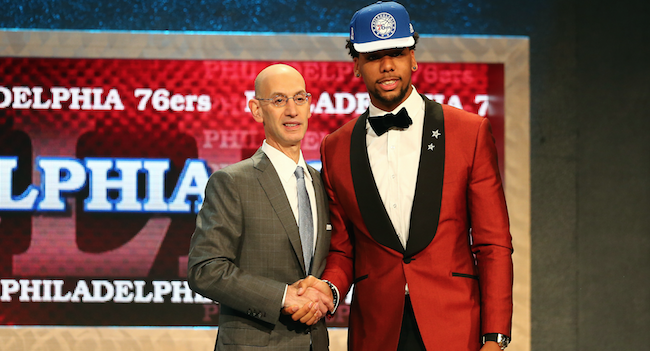
Picks/Trades: Jahlil Okafor (3); Arturas Gudaitis (47); J.P. Tokoto (58); Luka Mitrovic (60); Traded No. 35 pick, Guillermo Hernangomez, to New York for a pair of future second-rounders.
Credit Sam Hinkie for always being himself. Many assumed this was the year Philly would finally consider need over talent if their top choices were off the board, but that thinking proved unsurprisingly foolish.
Okafor will be a handful offensively in the NBA. His repertoire of post moves is rare even at the highest level, let alone for a 19-year-old. The Duke freshman should step into the league and be able to score from the block with the ease and nuance of an established veteran. His ability to pass out of double-teams is impressive for a player his low experience level, too.
But there’s a ceiling to his game that those of Towns, Russell, Porzingis, and others lack, and it’s not solely due to his deficiencies on the defensive end. Will Okafor ever develop into a reliable jump-shooter, let alone free throw shooter? It’s the latter drawback that could prove especially detrimental to his development. And playing in one of the league’s most uptempo systems, one wonders how he’ll adapt at the very beginning of his career, too.
That’s thinking too far ahead, obviously. And if Okafor merits a wholesale schematic change from Brett Brown, it will surely be implemented. For now, though, the Sixers simply have another valuable asset to throw in Hinkie’s cupboard full of them. Will they look to trade one of Okafor, Nerlens Noel, or Joel Embiid? Perhaps. The most prudent approach, however, might be revisiting that idea after 2015-16 – when Philadelphia can get a better feel for what it has in not only Okafor, but also Embiid.
We’ve only heard of one of the team’s second-round picks: J.P. Tokoto. The North Carolina wing is a fantastic athlete with awesome defensive ability, but can’t stretch the floor to save his life. Sound familiar? The Sixers take a flier on a couple of these guys every year, and sometimes, like Jerami Grant, they even pan out.
Phoenix Suns: C+
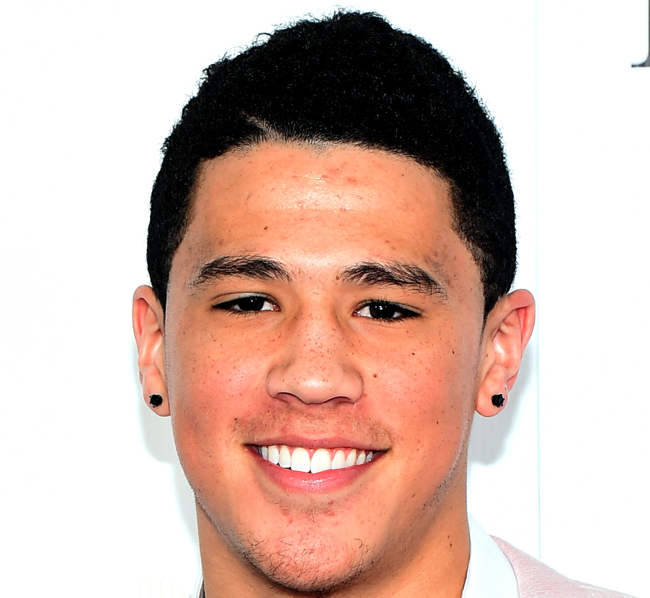
Picks: Devin Booker (13); Traded the No. 46 pick, Andrew Harrison, t0 Memphis For Jon Leuer
We’re not very high on Booker. Though he’s obviously a marksman, the youngster just didn’t show enough at Kentucky for us to believe he’ll be anything more than a role player at the next level. But those guys have value, especially for a shooting-strapped team like Phoenix. Just don’t expect Booker to live up to so many Klay Thompson comparisons; he’s not that guy.
Two reasons we could be wrong: He’s only 18 years old and fared extremely well in athletic testing at the pre-draft combine.
Portland Trail Blazers: B
Trade: Acquired Mason Plumlee and the No. 43 pick, Pat Connaughton, from Brooklyn in exchange for the No. 23 pick, Rondae Hollis-Jefferson, and Steve Blake
How are the Blazers rebounding from the supposedly imminent departure of LaMarcus Aldridge. By plugging and playing with Plumlee, of course!
Seriously, this deal is a good one for Portland. Plumlee flashed some nuanced scoring ability before falling out of favor with the Nets last season, and still projects as a plus defender, too. Locked into a bargain contract for the next two seasons before hitting restricted free agency, he could be eventually become one of the league’s better bargains.
Is he worth a first-round pick? Considering Plumlee was taken 22nd overall in 2013 and has done nothing to prove that selection was a mistake, another choice in the early 20s seems a fair price.
Connaughton, meanwhile, will surely be a fan favorite for the Blazers – just like he was in the NCAA Tournament. The high-motor Notre Dame guard is a jack of all trades but a master of none, normally a death-knell for players with his on-court physical profile. Considering he tested off the charts at the pre-draft combine, though, perhaps Connaughton’s athleticism will translate to the floor in the more wide open NBA game.
Sacramento Kings: A-
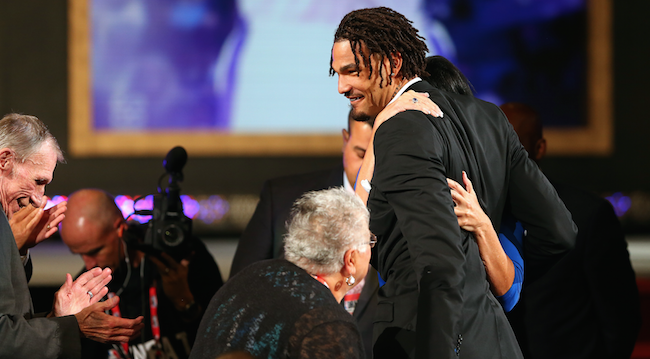
Picks: Willie Cauley-Stein (6)
Everything in Sacramento orbits around the uncertain status of DeMarcus Cousins. Until the team knows whether or not its franchise player will around for the long-haul, it will be held hostage by that unknown from a decision-making perspective. Except, apparently, with this draft choice.
Cauley-Stein is one of the most athletically gifted seven-footers we’ve ever seen. He runs, jumps, and slides like a player far eight inches shorter, and has the NABC Defensive Player of the Year award to prove it. The Kentucky center will have a finite roll in the NBA offensively as a ball-screen dive man, but other players cut from the same cloth have carved out extremely meaningful careers despite that limit.
Basketball is played on two sides of the floor, and Cauley-Stein has the look of a potential Defensive Player of the Year. He’s an awkward alongside Cousins offensively, but there’s a chance the All-Star is skilled enough to compensate for the lack of space yielded by the presence of a non-shooter alongside him in the frontcourt. And if Boogie gets traded? George Karl has the fleet-footed big man that’s a perfect fit for his run-and-gun ethos.
The only problem for Cauley-Stein could be an ankle issue that some teams red-flagged during the pre-draft process. Health provided, he’ll be a stalwart of All-Defense teams for many, many years going forward.
San Antonio Spurs: ???
Picks: Nikola Milutinov (26); Cady Lalanne (55)
Why lie? We hadn’t heard of either San Antonio selection until they were announced on draft night. Those in the know are extremely fond of Milutinov, though, who seems a classic stash candidate who could prove a steal for the Spurs.
Toronto Raptors: B
Picks: Delon Wright (20); Traded Greivis Vasquez to the Milwaukee Bucks for a future lottery-protected first-rounder and Norman Powell, the No. 46 pick
Wright won’t be setting the world on fire. He’s not a shooter or a natural scorer, and doesn’t quite possess the innate playmaking ability you want from a lead guard. But the Ute has excellent size for his position and his motor always runs hot, attributes that could combine to make him an impactful defender of both 1s and 2s. As long as he’s surrounded by shooting, Wright should find a home as a third guard in the NBA.
His addition makes even more sense considering Toronto traded Greivis Vasquez to Milwaukee for a future first-rounder and could lose reigning Sixth Man of the Year Lou Williams in free agency. Not every pick has to be sexy. Some simply fill a need and won’t rock the boat, and Wright is definitely among them.
Utah Jazz: B+
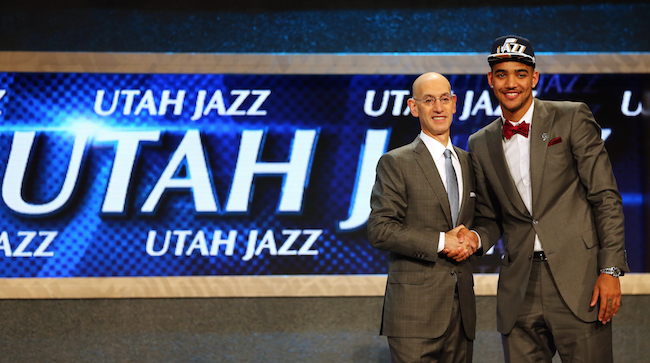
Picks: Trey Lyles (12); Olivier Hanlan (41); Daniel Diez (54)
Utah could be the best defensive team in basketball next season. Rudy Gobert would have been in the Defensive Player of the Year discussion if he’d been a starter before the trade deadline, and Derrick Favors’s combination of length, strength, and quickness makes him an extremely imposing defender, too. But all that size on the interior limits what the Jazz can do offensively.
Enter Lyles, a playmaking forward who could play alongside both incumbents. The Canadian was forced to play out of position on the wing in his lone season at Kentucky due to a surplus of frontcourt talent, yet 8.7 points and 5.5 rebounds on 48.8 percent shooting in just 23.0 minutes per game. What could most spark Lyles from serviceable to impactful is an improved jumper. He all the characteristics of a classic stretch 4 except the most important one: shooting range. He made just 4-of-29 from beyond the arc during his freshman season and didn’t readily let fly from just inside it, either. If the jumper comes, Utah could have itself the perfect complement to Favors and Gobert. If not, his ability to put the ball on the floor and make plays for himself and others will still prove beneficial.
Hanlan is a steal, too. It’s no secret the Jazz aren’t in love with Trey Burke as the backup to Dante Exum, and the Boston College guard has the requisite feel and jump-shot to play minutes at both guard spots. If Utah decides to move Burke this offseason, don’t be surprised if Hanlan emerges as a meaningful reserve in his rookie year.
Washington Wizards: B+
Picks/Trades: Selected Kelly Oubre with the 15th pick after trading No. 19 and two future second-rounders to Atlanta; Aaron White (50)
There’s no way to know what Washington will be getting with Oubre.
The Kansas freshman has all the physical attributes scouts look for in a modern day wing: He’s 6-foot-7 with a 7-foot-2 wingspan, is an effortless slider, and has enough explosion to finish above the rim. Oubre even flashed semi-reliable three-point range and a developing floor-game for Bill Self. The question is if his game will ever live up to all of those natural gifts. He saw scant playing time during the early portion of his freshman season due to poor work ethic and an inability to grasp high-level defensive concepts. Once the lefty finally embraced the grind, though, he became one of the most effective two-way players in the Big XII.
Which Oubre will show up for the Wizards next season and for the long haul? Odds are that he settles in somewhere between his floor and ceiling as a ‘3-and-D’ type who makes a sizable impact on a winning team. Just don’t expect him to show even that tepid promise next season, however. While Oubre’s a project, he’s certainly one worth taking on.






